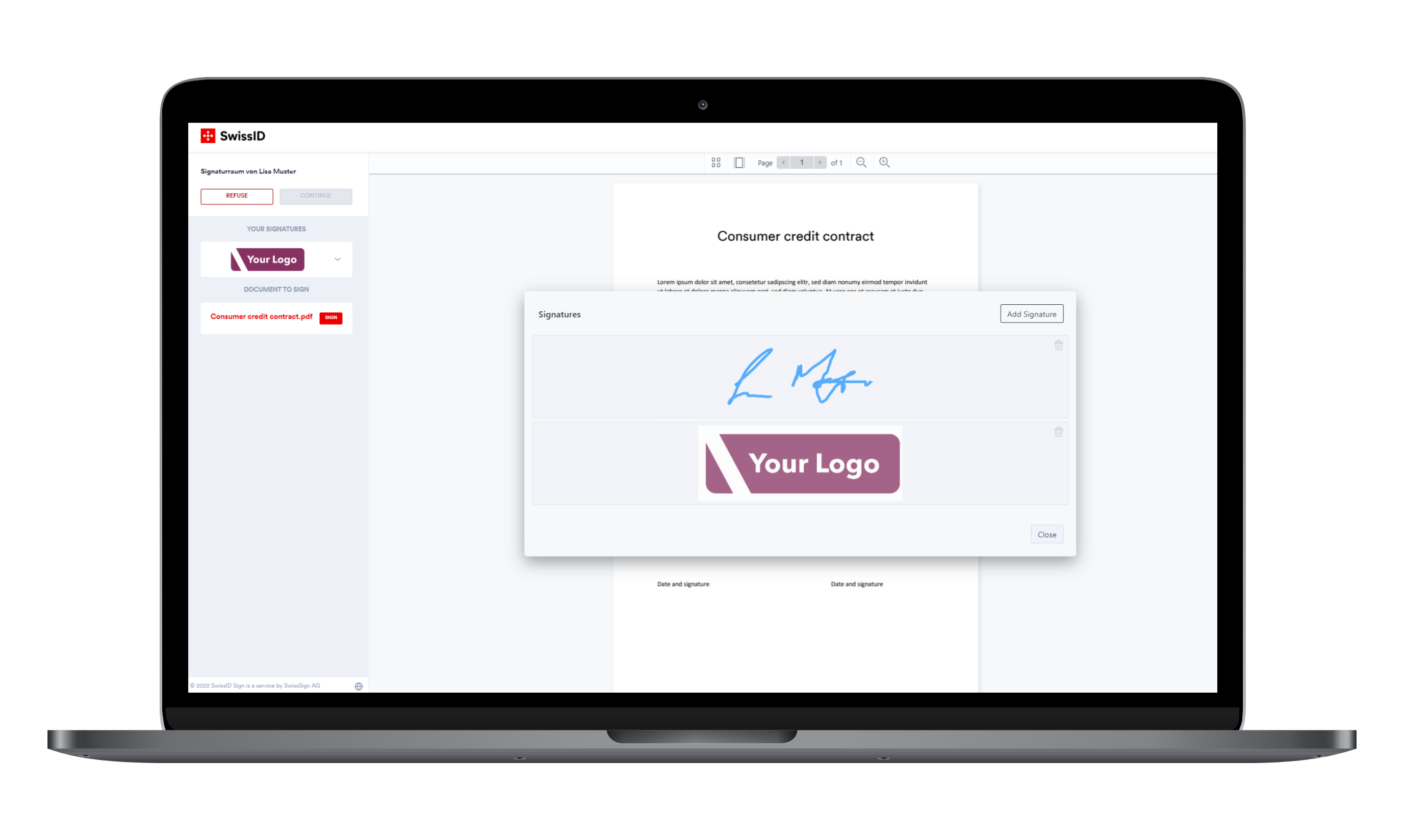Main section
How to personalise your electronic signature
Want to add a company logo to your electronic signature? We’ll show you how easy it is and explain why the signature’s appearance isn’t what matters most.
Here’s how it works
Let’s get one thing out of the way: the visual appearance of an electronic signature is of secondary importance. First and foremost, the technical requirements for an electronic signature need to be met. Let’s explore this a little.
Strictly speaking, an electronic signature is a purely technical process. For qualified electronic signatures, this process encompasses various elements. One is that the signatory needs to be clearly identifiable, or in other words, the signature has to be incontrovertibly attributable to a particular person. As a result, the signer’s identity also needs to be verified before they undertake their first signature. The electronic signature ensures that subsequent changes to the document can be identified as well, thus ensuring the integrity of the document. In the case of qualified electronic signatures, it is also mandatory in Switzerland to record the time of signature, as well as the signature itself. Plus, only official providers of trust services, such as SwissSign, can offer qualified electronic signatures that are valid in Switzerland. Specifically, they need to comply with the strict requirements of the Swiss Federal Act on Electronic Signatures (ESigA).
What electronic signatures are there?
In the analogue world, we most often encounter handwritten signatures, as well as verbal agreements. The digital world, however, is in fact home to three different and relevant signature standards: the simple, advanced and qualified electronic signature. But how do they differ, and what purpose does each signature serve?

Qualified electronic signature (QES)
The QES meets the highest signature standards and is equivalent to a handwritten signature (Art. 14 (2)bis Swiss Code of Obligations). The Swiss Federal Act on Electronic Signatures (ESigA) therefore requires that an identity verification of the signatory be performed prior to the initial signature. This kind of identity verification can only be performed by an official Trust Service Provider, such as SwissSign. An identity verification can be performed online or on site. The identity of the signatory and the authenticity of the signature are therefore unambiguously guaranteed. The QES has high evidentiary value in a court of law.
Use cases: You need a QES for documents with formal legal requirements and with a high liability risk. Examples include consumer credit contracts, rental/lease contracts, including associated termination documents, audit reports and temporary employment contracts.

Advanced electronic signature (AES)
Unlike with the qualified electronic signature, in the case of the advanced electronic signature, there is no clear statement on how the identification of the signatory should take place. Nevertheless, this remains a requirement before the initial signature is provided. Depending on the signature provider, various different options are therefore available, e.g. via mobile phone number.
Use cases: The AES is often used in agreements and standard contracts that are not subject to any formal legal requirements and have a calculable liability risk. Examples include purchase agreements as well as simple employment contracts.

Simple electronic signature (SES)
The simple electronic signature is the standard with the lowest requirements in terms of security level. There are no special requirements here regarding the signature’s origin and authenticity under law. A scanned signature that you insert into a PDF can, in some cases, also be used as a simple electronic signature. It has low evidentiary value if, for example, you want to prove something in a court of law.
Use cases: The SES is used for documents that are not subject to any formal legal requirements and also have a very low liability risk. Examples include internal documents, supplier orders, signing invoices or protocols.
What is the right signature for your case?
-
Choosing the right signature primarily depends on which type of document you want to sign. You can use the use cases listed above as a potential guide.
-
If you are still unsure about which signature to use, we recommend seeking legal advice or, if need be, directly contacting the party that requires your signature.
-
Prefer to be on the safe side? Then we recommend the QES (highest signature standard). This is because the QES also covers all of the use cases that in principle do not demand any formal legal requirements.
The Swiss Confederation offers a validation tool so you can check whether a qualified electronic signature on a document is valid: upload the document in question to the tool, and, in seconds, it will check and confirm the validity of the signature.
What does the electronic signature look like?
Alongside the technical requirements, it goes without saying that users set store by the signature’s visual appearance, too. SwissID Sign’s standard signature depicts the full name of the signatory, in line with their identity document, and the date and type of signature. The signature can be positioned wherever wished within the document.
How can you add your handwritten signature?
As you might also want to use the electronic signature in a business context, you can add, say, a company logo to it as a visual element, if desired. This ensures it is suitably memorable for recipients. Alternatively, upload your handwritten signature as an image to give your signature the personal touch. Can’t decide? No problem – you can store as many signature images as you like in your signing room.






